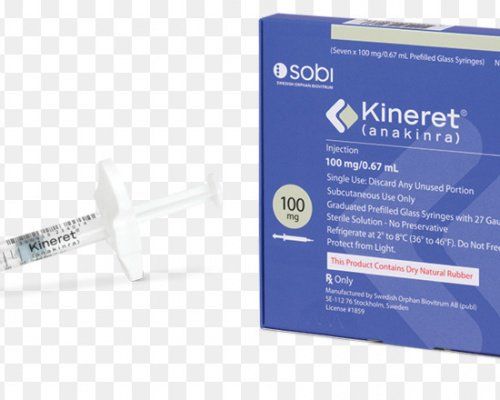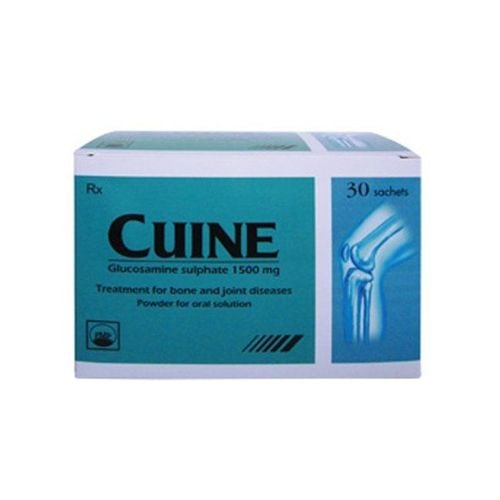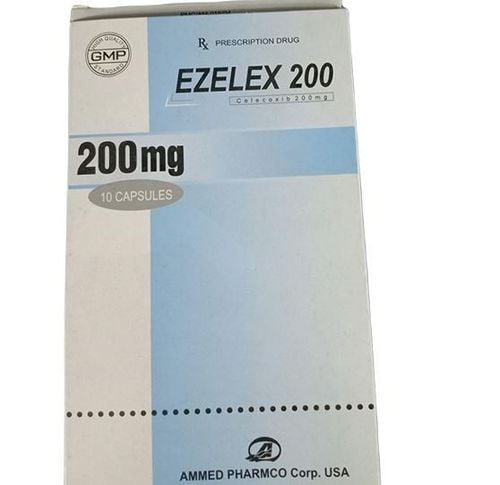This is an automatically translated article.
Celecoxib is a widely used NSAID drug for the relief of pain caused by various medical conditions. This active ingredient is present in the drug Locobile 200 mg. So what is Locobile 200 and how should it be used?1. What is Locobile 200?
Locobile 200mg is a product of Windlas Biotech Pvt.Ltd (India) with the main ingredient being the active ingredient Celecoxib 200mg.
Locobile 200 is prepared and manufactured in the form of hard capsules, packed in each box of 3 blisters, equivalent to 1 blister with 10 tablets.
2. Indications of the drug Locobile 200 mg
Locobile 200 is indicated for pain relief and symptomatic treatment in:
Osteoarthritis; Rheumatoid arthritis ; Ankylosing spondylitis; Acute attacks of pain; Dysmenorrhea (dysmenorrhea).
3. Pharmacology of the drug Locobile 200mg
3.1. Pharmacodynamics Celecoxib in Locobile 200 belongs to the group of non-steroidal anti-inflammatory drugs (NSAIDs) that selectively inhibit the COX-2 enzyme. The mechanism of action of Locobile 200 is to inhibit prostaglandin synthesis, through inhibition of the isoenzyme Cyclooxygenase-2 (COX-2), thereby reducing the formation of prostaglandin precursors.
The advantage of Locobile 200 is that it is selectively inhibiting COX-2, so it limits the adverse effects on the gastrointestinal tract compared to non-selective NSAIDs.
3.2. Pharmacokinetics Absorption: Locobile 200 is well absorbed from the gastrointestinal tract. Peak plasma concentrations of Celecoxib are achieved 3 hours after administration of 1 Locobile 200 mg tablet. When taken with a greasy meal, peak plasma concentrations of Locobile 200 are delayed for approximately 1 to 2 hours with an increase in AUC of approximately 10% to 20%.
Distribution: Locobile 200 is 97% bound to albumin, to a lesser extent to acid glycoprotein.
Metabolism: Celecoxib is metabolized mainly via cytochrome P450 CYP2C9 in the liver to 3 metabolites: alcohol-containing compounds, carboxylic acid-containing compounds and glucuronide conjugates. CYP3A4 is also involved in the metabolism of Locobile 200 but to a lesser extent.
Elimination: Locobile 200 is eliminated by hepatic metabolism as unchanged drug (less than 3%) in the urine and faeces. The remaining 57% of the dose is excreted in the faeces and 27% in the urine.
4. Instructions for using Locobile 200 mg
Locobile 200 is in hard capsule form and is for oral use only.
The usual starting dose of Celecoxib is 100 mg (1⁄2 Locobile 200 tablets), which can then be adjusted according to the patient's condition.
Note that the cardiovascular risks of Locobile 200 may increase with dose and duration of use, therefore it is recommended that only Locobile 200 be treated for the shortest time at the lowest effective dose. At the same time, doctors need to periodically assess the patient's pain relief and response to the treatment regimen during the use of Locobile 200, especially patients who have to take it regularly such as osteoarthritis.
Recommended dose of Celecoxib in some specific cases:
Osteoarthritis: The recommended dose is 200mg/day, equivalent to 1 Locobile 200 tablet, can be divided into 1-2 doses. In some patients who are not achieving analgesia, the dose may be increased to 200 mg twice daily. If after 2 weeks of treatment with Locobile 200 the goal is not reached, the doctor may consider other treatment options; Rheumatoid Arthritis: The recommended initial dose is 200mg, divided into 2 or more times daily, may be increased to 200mg twice daily (1 Locobile 200 x 2 tablet orally per day). The patient should be considered to change the drug if after 2 weeks of treatment there is no effect; Ankylosing spondylitis: The daily dose is 200mg/time (1 Locobile 200 tablet), 1-2 times a day. A small number of unresponsive patients can be increased to 400 mg/day in 1 or 2 divided doses. However, other drug therapy should be considered if pain does not improve after 2 weeks of using Locobile 200; Acute pain: Initial dose 400mg orally (2 Locobile 200 tablets), can take 1 more Locobile 200 tablet if needed in the first day, then maintain 200mg x 2 times orally in the following days; Primary dysmenorrhea (dysmenorrhea): The dose is similar to that of acute pain. Dosage of Locobile 200 in some special subjects:
Elderly (> 65 years old): 200mg/day at the beginning of treatment, if necessary, it can be increased to 200mg x 2 times/day. However, caution should be exercised when using Locobile 200 for elderly people weighing less than 50kg; Children: Locobile 200 mg is not recommended; Poor metabolisers via CYP2C9: Celecoxib use carries a high risk of dose-dependent adverse events, therefore caution should be exercised and a dose reduction of 1⁄2 (lowest dose) is recommended in normal subjects; Patients with hepatic impairment with serum albumin concentrations 25-35g/l need to reduce by 1⁄2 compared to the normal dose at the beginning of treatment; Patients with renal impairment: Clinical data in patients with mild to moderate renal impairment are still limited. Therefore, when using Locobile 200 for this group of patients, you must be really careful.
5. Side effects of the drug Locobile 200 mg
Increased risk of cardiovascular thrombosis; Hypertension (including paroxysmal hypertension); Sinusitis, pharyngitis, upper respiratory or urinary tract infections; Hypersensitivity; Insomnia; Dizziness, increased muscle tone; Heart attack ; Rhinitis, cough, difficulty breathing; Nausea, abdominal pain, diarrhea, indigestion, flatulence, vomiting, difficulty swallowing; Rash, itching; Ankle pain; Pseudo-flu disease; Peripheral edema, increased circulating volume; Anemia; Hyperkalemia ; Anxiety, depression, fatigue; Cerebral infarction; Sleep disturbance, somnolence; Vision disturbances, keratitis; Tinnitus; Heart failure, tachycardia, arrhythmia; Bronchitis. Abnormal liver function, increased liver enzymes AST and ALT; Increased creatinine and blood urea; Facial edema, chest pain Decrease in white blood cells, platelets; Confusion, hallucinations; Conjunctival hemorrhage; Gastrointestinal bleeding, peptic ulcer, esophageal ulcer, pancreatitis, colitis; Hepatitis; Menstrual disorders; Cerebral hemorrhage, aseptic meningitis, epilepsy; Retinal artery/vein occlusion.
6. Contraindications of Locobile 200
People with hypersensitivity to Celecoxib, Aspirin or other NSAIDs; People who have ever had an allergic reaction to a sulfonamide; People who have ever had bronchial asthma, urticaria, allergies or allergic reactions after using Aspirin and other NSAIDs; Peptic ulcer disease or gastrointestinal bleeding; Pregnant women, women of childbearing potential without effective contraception; Breastfeeding mothers; Severe liver failure, serum albumin < 25 g/l or Child Pugh index ≥ 10; Severe renal impairment (creatinine clearance < 30ml/min); The patient is suffering from inflammatory bowel disease; Congestive heart failure (NYHA II - IV); Ischemic heart disease, peripheral artery disease, cerebrovascular disease; The patient had just undergone coronary bypass surgery.
7. Some cautions when using Locobile 200
Effects on the digestive system: Gastrointestinal complications such as ulceration, perforation, bleeding (even leading to death) have been reported in patients treated with Celecoxib. Therefore, caution should be exercised when prescribing Locobile 200 to patients at high risk of gastric complications with NSAIDs, the elderly, concurrent users of other NSAIDs or acetylsalicylic acid, glucocorticoids, alcoholics or those with a pre-existing condition. history of gastrointestinal disease such as ulcers and diarrhea. Risk of adverse gastrointestinal effects when Locobile 200 is used concomitantly with acetylsalicylic acid (even at low doses).
Concomitant use of NSAIDs: The use of Locobile 200 with other NSAIDs (except Aspirin) should be avoided. Cardiovascular thromboembolic risk: Systemic administration of NSAIDs (non-aspirin) may increase the risk of cardiovascular thrombotic events, including myocardial infarction and stroke, which can, more seriously, lead to cardiovascular events. dead. This risk may appear as early as a few weeks and may increase with the duration of Locobile 200 use. Selective COX-2 inhibitors such as Locobile 200 do not replace acetylsalicylic acid in the prevention of coronary heart disease by inhibiting platelet aggregation.
Hypervolemia and Edema: As with other drugs that inhibit prostaglandin synthesis, hypervolemia and edema have been reported in patients receiving Locobile 200. Therefore, it should be used with caution in patients with a history of heart failure, left ventricular dysfunction or hypertension, or in those with a history of edema from any cause. Inhibition of prostaglandins can impair renal function and increase fluid volume, thus requiring caution in patients treated with diuretics or at risk for hypovolemia.
Hypertension: Like all other NSAIDs, Locobile 200 may induce the onset of hypertension, worsen hypertension or increase the incidence of cardiovascular events. Therefore, blood pressure should be closely monitored at the beginning of treatment and throughout treatment with Locobile 200.
Effects on the liver and kidneys:
Side effects that damage kidney function, liver and especially heart failure have a high risk of occurring in the elderly, so it is necessary to have a plan to monitor this subject when taking Locobile 200 ; Patients at high risk of nephrotoxicity are those with a history of kidney failure, heart failure, liver dysfunction, using drugs such as diuretics, ACE inhibitors, angiotensin II receptor blockers... and people elderly. These patients should be carefully monitored during treatment with Locobile 200; Some cases of severe hepatic impairment with Locobile 200, including fulminant hepatitis, hepatic necrosis and hepatic failure have been reported. Most serious liver events occurred within one month of starting Celecoxib therapy. Inhibition of CYP2D6 enzymes: The celecoxib in Locobile 200 inhibits the CYP2D6 enzyme. Although not strongly inhibiting this enzyme, it requires reducing the dose of drugs metabolized by CYP2D6.
Serious skin reactions, some fatal, have been reported with Locobile 200, including exfoliative dermatitis, Stevens - Johnson syndrome, toxic epidermal necrolysis... with a rare frequency. . Patients with a history of sulphonamide allergy or any other drug allergy are at risk of serious skin reactions or hypersensitivity reactions due to Celecoxib. The celecoxib in Locobile 200 mg may mask fever and other symptoms of inflammation or infection.
Use of Locobile 200 with oral anticoagulants:
Serious bleeding events have been reported, including an increase in the INR. Therefore, patients with Locobile 200 should be closely monitored concomitantly with warfarin/coumarin oral anticoagulants; Caution should be exercised when celecoxib is combined with warfarin or other oral anticoagulants, including new anticoagulants (eg, apixaban, dabigatran and rivaroxaban). Pregnancy: Data from epidemiological studies suggest an increased risk of spontaneous abortion following the use of a prostaglandin synthesis inhibitor such as Locobile 200 in early pregnancy. Potential harm to the fetus is unknown, but cannot be ruled out. Locobile 200, like other drugs that inhibit prostaglandin synthesis, can cause uterine contractions and premature closure of the ductus arteriosus in the third trimester of pregnancy. Therefore, Locobile 200 is contraindicated for use in women who are pregnant or wish to become pregnant.
Lactation: Locobile 200 is excreted in the milk of lactating rats at concentrations similar to those in plasma. The use of Locobile 200 has been studied in a limited number of lactating women and very low levels of celecoxib have been reported in breast milk. However, women taking Locobile 200 should not breastfeed.
8. Drug interactions of Locobile 200
Anticoagulants: Anticoagulant activity should be monitored, especially during the initial period, when initiating or changing the dose of Locobile 200 in patients receiving Warfarin or other anticoagulants due to the risk of bleeding complications. high blood. Patients on oral anticoagulant therapy should be closely monitored for prothrombin time or INR, especially during the initiation or change of Celecoxib dose.
Antihypertensives: NSAIDs such as Locobile 200 may decrease the effectiveness of antihypertensive drugs, including ACE inhibitors, angiotensin II receptor blockers, diuretics, and beta blockers. .
Cyclosporin and tacrolimus: The combination of Locobile 200 and Cyclosporin or Tacrolimus may increase nephrotoxicity, therefore renal function should be monitored periodically.
Acetylsalicylic acid: Locobile 200 can be used concurrently with low-dose acetylsalicylic acid but not as an alternative for the prevention of cardiovascular events.
Inhibitors of CYP2D6 Enzymes: Locobile 200 is an inhibitor of CYP2D6, therefore plasma concentrations of drugs metabolized by this enzyme may be increased with concomitant administration.
CYP2C19 Enzyme Inhibitors: In vitro studies have shown that Locobile 200 can inhibit CYP2C19, however clinical data are unclear. Drugs metabolised by CYP2C19 are Diazepam, Citalopram and Imipramine.
Methotrexate: Rheumatoid arthritis patients used concomitantly Celecoxib and Methotrexate (low dose) had an interaction but not statistically significant. However, the toxicity associated with methotrexate must be fully considered when these two drugs are combined.
Lithium: In healthy subjects, taking Locobile 200 x 2 times/day with Lithium 450mg x 2 times/day increased average Cmax 16% and AUC 18% with lithium concentrations. Therefore, lithium-treated patients should be closely monitored when co-administering Locobile 200 or consider discontinuing lithium.
Oral contraceptives: Locobile 200 had no clinically relevant effect on the pharmacokinetics of oral contraceptives (Norethisterone 1mg/35 micrograms Ethinylestradiol).
Glibenclamide/tolbutamide: Locobile 200 did not affect the pharmacokinetics of Tolbutamide (metabolized via CYP2C9) or Glibenclamide.
Drugs Poorly Metabolized by CYP2C9 Enzymes: Drugs that are poorly metabolized by CYP2C9 enzymes may potentiate the systemic effects of Locobile 200, and concomitant treatment with this class of drugs (e.g. fluconazole) will increase celecoxib concentrations.
Please dial HOTLINE for more information or register for an appointment HERE. Download MyVinmec app to make appointments faster and to manage your bookings easily.













